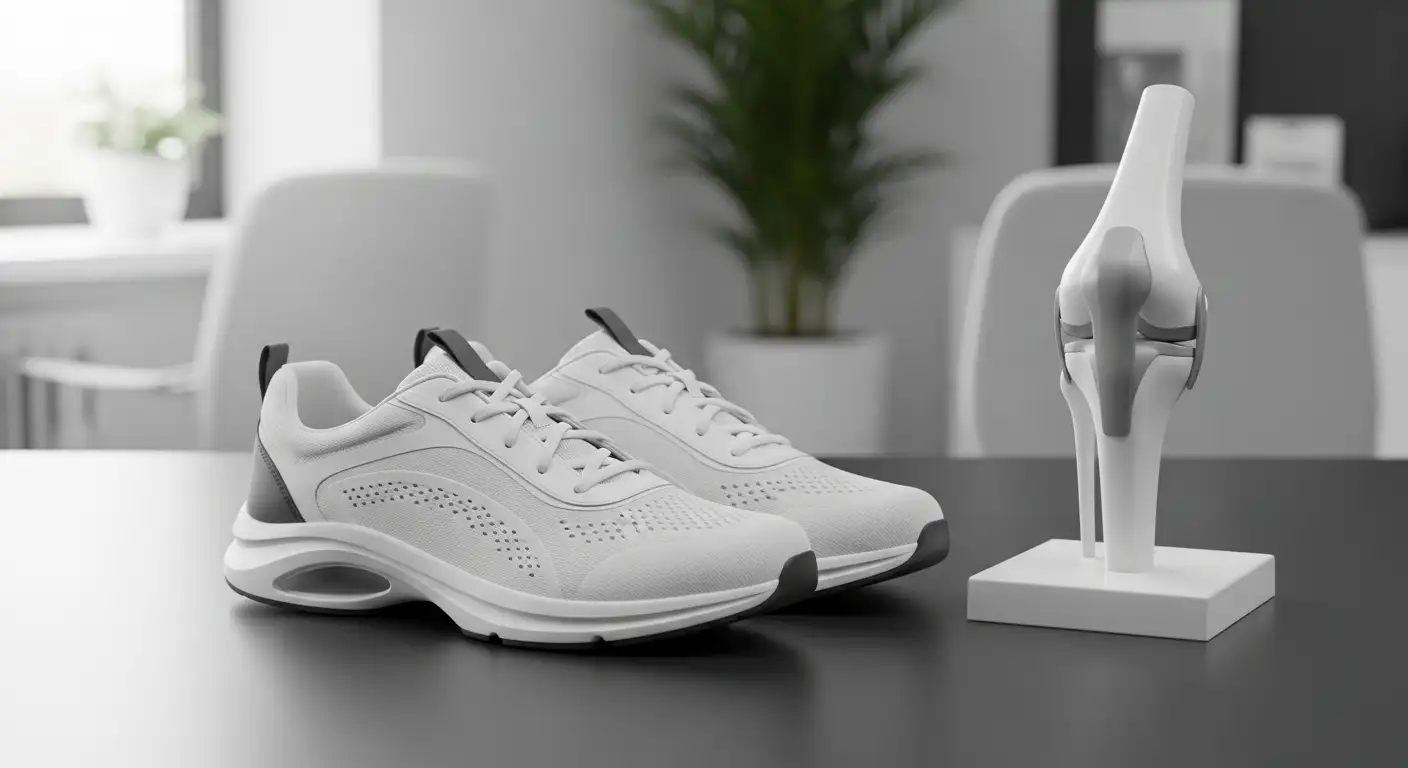Understanding Knee Pain
Before diving into the specifics of knee pain when squatting, it's important to first understand the basics of knee anatomy and the common causes of knee pain.
The Anatomy of the Knee
The knee is one of the largest and most complex joints in the body. It consists of four main components: the femur (thigh bone), the tibia (shin bone), the patella (kneecap), and the fibula (smaller bone next to the tibia). These bones are connected by a series of ligaments, tendons, and muscles which help facilitate movement and provide stability to the joint.

One of the key components related to knee pain when squatting is the patellar tendon. This tendon connects the kneecap to the shin bone and plays a crucial role in the ability to straighten the knee and perform activities like running, jumping, and squatting.
Common Causes of Knee Pain
Knee pain is a common complaint among people of all ages, and it can have a wide range of causes. Acute injuries such as ligament tears or bone fractures can lead to immediate and severe knee pain. Chronic conditions like osteoarthritis or tendonitis can also cause persistent knee pain that worsens over time.
When it comes to experiencing pain on top of the knee when squatting, there are a few potential culprits. One common cause is patellar tendonitis, an inflammation of the tendon connecting the kneecap to the shinbone. This condition can cause pain and tenderness at the front of the knee, especially during activities that put pressure on the joint like squatting.
Another possible cause of pain on top of the knee when squatting is stress or strain on the knee joint, often due to improper squat form or overuse. This can lead to inflammation of the quadriceps tendon, which is located at the top of the kneecap.
Understanding the anatomy of the knee and the common causes of knee pain is the first step in addressing and managing pain on top of the knee when squatting. The following sections will delve deeper into the specific conditions that can cause this type of knee pain, as well as prevention and treatment options.
Knee Pain and Squatting
Understanding the relationship between squatting and knee pain is crucial in identifying potential problems and finding appropriate solutions. Squatting is a common exercise and daily activity, but when done incorrectly or excessively, it may lead to knee pain.
Impact of Squatting on the Knee
Squatting is a compound movement that engages multiple muscle groups and joints, including the knees. While this exercise can strengthen the muscles supporting the knee joint, it can also put a significant amount of stress on the knees, particularly if not done with proper form.
Pain on top of the knee when squatting might be a result of patellar tendinitis, an inflammation of the tendon connecting the kneecap to the shinbone. This pain could also be a sign that the knee is under stress, possibly due to poor squat form or overloading the knee joint, causing inflammation on the quadriceps tendon.
Recognizing Pain during Squatting
Recognizing pain during squatting is crucial in preventing further injury. Pain on the top of the kneecap when squatting could be due to patellar tendonitis, which is an inflammation of the tendon that connects the kneecap to the shinbone. Individuals with this condition may experience pain that gets worse when they jump, kneel, or squat.
If you feel a sharp or persistent pain on top of your knee when squatting, it's important to stop the activity and rest. Continuing to squat through the pain could lead to more serious injuries. If the pain persists even after taking a break, it may be time to seek medical help.
In summary, understanding the impact of squatting on the knee and recognizing pain during squatting are important steps in managing knee health. Proper form, appropriate load, and listening to your body are key to preventing knee pain and injuries during squatting. If you're experiencing persistent knee pain, don't hesitate to seek professional help.
Common Conditions Causing Knee Pain
Experiencing pain on top of the knee when squatting can be indicative of certain medical conditions. In this section, we will discuss some of the common conditions that might cause this type of knee discomfort: Patellar Tendonitis, Patellofemoral Pain Syndrome, and Osteoarthritis.
Patellar Tendonitis
Patellar Tendonitis, also known as Jumper's Knee, is a condition characterized by inflammation of the patellar tendon, which connects the kneecap to the shinbone. This condition is typically the result of overuse, muscle imbalance, and poorly fitting shoes that disrupt a person's natural gait [1]. Repetitive stress on the patellar tendon during activities like squatting, running, or jumping can lead to this condition [2].
Individuals with Patellar Tendonitis may experience pain that worsens when they jump, kneel, or squat. Additional symptoms can include tenderness, swelling, or a burning sensation around the knee [2].
Modifying squat technique, reducing weight, or seeking advice from a physical therapist can prevent further damage. Strengthening exercises for the quadriceps and hamstrings, as well as stretching the muscles around the knee, can help prevent and treat Patellar Tendonitis [2].
Patellofemoral Pain Syndrome
Patellofemoral Pain Syndrome, commonly known as Runner's Knee, can lead to knee pain while squatting due to misalignment and movement issues associated with the kneecap. This condition results in wear and tear of the cartilage on the back of the kneecap, causing inflammation and pain after squats.
Like Patellar Tendonitis, the pain may intensify when squatting, going up or down stairs, or after sitting for long periods. Proper exercise techniques, including correct squat form, can help prevent and treat this condition.
Osteoarthritis
Osteoarthritis, a common form of arthritis, can cause knee pain while squatting. As the cartilage cushioning the ends of the bones wears off, the compression of the cartilage during squats increases friction between the bones, resulting in inflammation, stiffness, and pain [4].
In addition to pain during squats, individuals with Osteoarthritis may experience joint stiffness, particularly in the morning or after periods of inactivity. Although this condition is generally associated with aging, it can also result from joint injuries or obesity.
Prevention and management strategies for osteoarthritis typically include regular low-impact exercise, weight management, and, in some cases, medication or physical therapy. It's crucial to consult with a healthcare professional for an accurate diagnosis and treatment plan if you experience persistent knee pain when squatting.
Prevention and Treatment Options
Understanding how to prevent and address knee pain when squatting is crucial in maintaining both the health and functionality of the knee joint. The following sections will discuss correct squatting techniques, exercises for strengthening and stretching the knee, and guidance on when to seek medical help for knee pain.
Correct Squatting Techniques
Pain on top of the knee when squatting might be a result of poor squat form or overloading the knee joint, causing inflammation on the quadriceps tendon [3]. To ensure proper form, one should maintain a hip-width stance with feet flat on the ground, keep the back straight, and bend at the knees and hips as if sitting down. The knees should not extend past the toes and the body weight should be in the heels during the movement. Modifying one's squat technique and reducing weight can help alleviate the stress on the knee and prevent further damage.
Strengthening and Stretching Exercises
In addition to proper form, strengthening and stretching exercises are vital in preventing knee pain when squatting. Strengthening exercises that target the quadriceps, hamstrings, and glutes can help support the knee and reduce the risk of pain and injury. Stretching exercises can help increase flexibility and range of motion, reducing the risk of overuse injuries such as patellar tendinitis.
When to Seek Medical Help
If pain on top of the knee when squatting persists despite modifications in squatting technique and exercise regimen, it may be a sign of an underlying condition such as patellar tendinitis or patellofemoral pain syndrome. In such cases, it's advisable to seek medical help. A healthcare professional can provide a proper diagnosis and recommend appropriate treatment options. These may include physical therapy, medication, or in some cases, surgery.
It's important to listen to one's body and not to ignore persistent knee pain. Early intervention can help prevent long-term damage and ensure the continued health of the knee. Remember, the goal is not just to alleviate the pain but also to address its cause and prevent future recurrence.
References
[1]: https://www.medicalnewstoday.com/articles/325246
[2]: https://www.healthline.com/health/knee-pain-when-squatting
[3]: https://docs.github.com/en/get-started/writing-on-github/working-with-advanced-formatting/creating-and-highlighting-code-blocks
[4]: https://www.physiotattva.com/blog/what-causes-knee-pain-when-squatting





